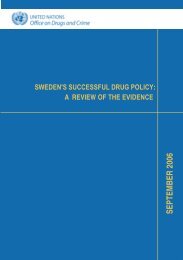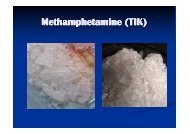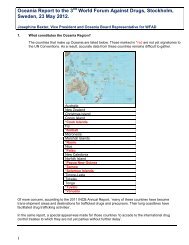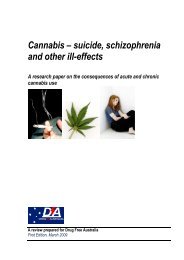International Research Compendium - Drug Free Australia
International Research Compendium - Drug Free Australia
International Research Compendium - Drug Free Australia
Create successful ePaper yourself
Turn your PDF publications into a flip-book with our unique Google optimized e-Paper software.
If the environment continues to pile stress on a former drug user, he/she will move to<br />
a level of susceptibility where he/she will return to uncontrolled addictive use with just<br />
one hit of drugs.<br />
Conditioned withdrawal can play a role in relapse.<br />
<strong>Research</strong>ers believe that these compensatory mechanisms can eventually be<br />
triggered by stimuli and cues previously associated with drug administration, and this<br />
can happen even before the drug is taken. In situations where the predictive stimuli<br />
appear but no drug is taken, the body’s compensatory mechanisms come into play<br />
and go unopposed because there is no drug effect.<br />
This can be expressed as overt physiological reactions and/or form the basis for the<br />
subjective experience of withdrawal sickness and craving.<br />
Example:<br />
A person is drinking alcohol every evening to reduce the anxiety they have<br />
experienced from working in a stressful job. The clock at work approaching 17h acts<br />
as a conditioned stimulus to the anxiety-alleviating effects of alcohol. If the person<br />
were to attend a school play one evening, without going to the pub, their body’s<br />
compensatory mechanisms would come into play but not to be diminished by the<br />
physiological effects of consumed alcohol.<br />
The person would experience the opposite subjective effects to those produced by<br />
alcohol: anxiety!<br />
Harm reduction messages, such as “responsible drug use” reinforces drug use<br />
through the mechanism of conditioning by associating these harm reduction<br />
messages with previous drug-related rewards! Exposure to psychoactive substances<br />
and substance use in everyday life and through the media, particularly when<br />
presented in a positive environment, can create pleasurable emotions. An individual<br />
can easily become conditioned to associate these emotions with substance use. And<br />
the mental ability to act responsibly is itself impaired by drugs, making the term<br />
“responsible drug use” both nonsense and contradictory.<br />
The mechanism of tolerance<br />
Tolerance can be defined as a given drug producing a decreasing effect with<br />
repeated dosing, or when larger doses must be administered to produce the same<br />
effect. The user requires a larger dose of that drug to get the effect that a smaller<br />
dose first produced. It reflects the body’s adaptation to a new chemical environment,<br />
one that includes the continuous presence, often at high concentration, of a particular<br />
drug.<br />
Tolerance can be understood through the principle of homeostasis, which describes<br />
how the body manages to keep its internal environment relatively stable.<br />
For example, a neuron that receives increased numbers of messages from another<br />
neuron that uses dopamine as a neurotransmitter might begin to remove dopamine<br />
receptors from its membrane and make fewer dopamine receptors overall. This<br />
process helps to keep the activity of the receiving neuron stable. The neurons in the<br />
brain can reduce the effects of the drugs that do get there, due to changes in<br />
receptor number or sensitivity.<br />
Tolerance can also develop as a result of metabolic enzyme induction ( enzymes that<br />
are involved in the metabolisation of a drug can increase their activity in the presence<br />
19






